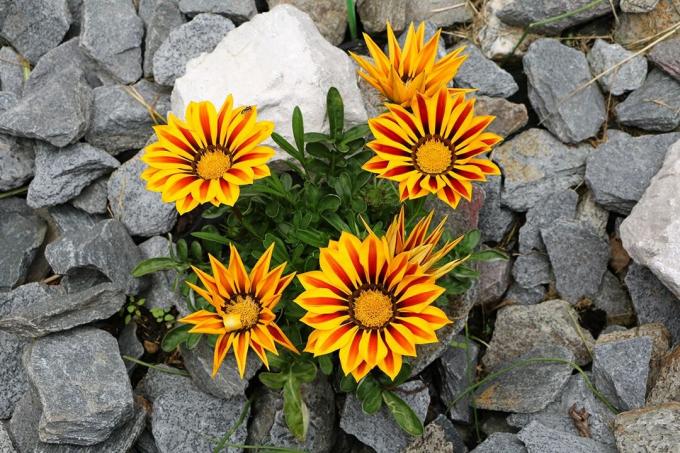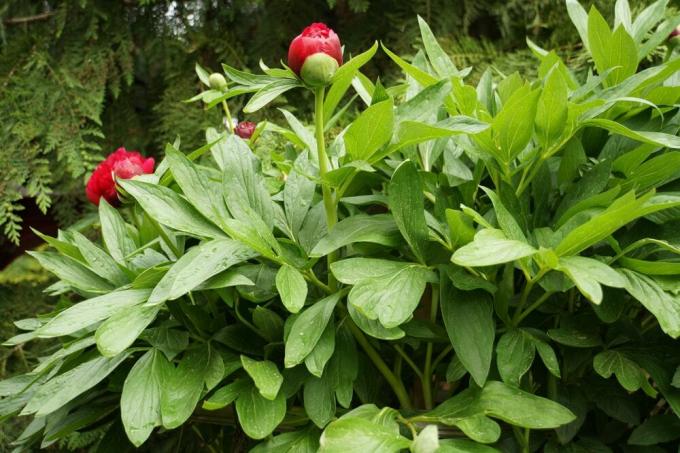

Table of contents
- soil/location
- Plant
- Pour
- Fertilize
- Cut
- hibernate
- Propagating by seeds
- Propagation by cuttings
- Possible diseases and pests
- Decorative species
- frequently asked Questions
- Worth knowing about Goldmarie shortly
- wintering
- multiply
The Goldmarie Bidens ferulifolia is a herbaceous plant with brightly colored yellow inflorescences and fine, elongated and heavily slit leaves. Due to the dense deciduous foliage, it is often used as a decorative ornamental plant. The Goldmarie is colloquially referred to as gold cosmos or gold fever. The botanical name of Bidens (Zweizahn) goes back to the fruits of the plant. They attach themselves to animal fur and clothing with their barbs, thereby gaining access to new habitats. Bidens ferulifolia is a grateful summer flower that requires minimal maintenance.
soil/location
So that Bidens ferulifolia grows well, it needs a well-drained soil. It should have enough nutrients. A soil improvement with sand or gravel and humus and a pH value between 5 and 6 have a positive effect on the growth of the Goldkosmos plant, because the Bidens originally comes from Mexico, where they grow in the wild between field plants grows. The Goldmarie forms the most flowers in a warm, sunny location. However, it also tolerates partial shade and shade, although a shady location can have an adverse effect on the abundance of flowers and produce more green foliage that forms a dense carpet. The Goldmarie with overhanging growth is often used for balcony boxes, hanging baskets, borders and roadsides. It does well in rock gardens and planters. The Goldkosmos plant is suitable for planting under tall stems and has recently been offered as a tall stem itself.
Plant
The Goldmarie grows between 30 and 60 cm high and develops new flowers between early summer and autumn, which attract many insects, bees and bumblebees with their slightly sweet scent. The planting distance should be around 30 cm in the bed and along the wayside so that the Bidens can develop well. About nine plants can be placed on one square meter. The planting depth for the young seedlings is 10 to 12 cm. A shady day is an advantage for planting out, so that the Goldmarie can settle in well. A partially shaded spot is appropriate until the seedlings have established themselves.
Pour
The soil should never dry out completely, although waterlogging is not tolerated. In midsummer, the busy perennial bloomer can be watered in the morning and evening.
Tip:
The Goldmarie sheds its flowers through waterlogging or a dry root ball! By the way: water is urgently needed, especially when the shoots are hanging limp.
Fertilize
The nutrient requirement is high because the Goldmarie keeps growing new shoots with flowers and leaves. However, the first fertilizer should only be applied when the perennial has grown properly. In the main season, in June, July, August and September, a weekly fertilizer application with commercially available liquid fertilizer is advantageous. With less fertilizer, the two-tooth does not grow as luxuriantly. However, even in rainy summers, it reliably forms many small yellow flowers that look like small suns.
Cut
Bidens ferulifolia does not usually need to be cut if rapid and voluminous growth is desired. Withered flowers do not need to be cut off. It is simply overgrown by new shoots and later falls off on its own. Bidens doesn't seed itself. If the faded flowers are removed, new flowers will quickly form. If the Bidens ferulifolia spreads too much, it can of course also be severely cut back if necessary.
Tip:
Removing the shoot tips in spring ensures bushier growth! A pruning in July/August extends the flowering period.
hibernate
Overwintering is not worthwhile if new cuttings were obtained from the mother plant in autumn. However, if Bidens ferulifolia grows in planters, a light, frost-free winter location between 5 °C and 10 °C is necessary. The two-tooth is only poured sporadically in the winter quarters. The root ball should not dry out completely. Because of the strong rooting, it needs new plant substrate and a larger plant container in spring. Commercially available potting soil is perfectly adequate. By the way: At the end of the winter period, the Goldmarie can be watered more.
Tip:
For a rich new shoot, the gold tooth is only cut back in spring!
Propagating by seeds
Bidens ferulifolia can be propagated by seeds or cuttings. This is more common than hibernation. For sowing, the seeds are collected from the withered flowers in autumn and sown under glass in January to February for early flowering. Sowing the seeds is still possible in March. The seeds are spread over the potting soil and lightly covered with soil. The germination period is around two weeks. During this time, the soil must be kept slightly moist at room temperature.
Propagation by cuttings
- Cut cuttings in early fall
- plant in growing substrate
- keep slightly moist
- until the roots have formed do not place in the blazing sun
- Overwinter young plants in a bright and frost-free place and plant outdoors in spring after the ice saints
Tip:
Do not expose young plants to the midday sun! This is not a problem with older plants.
Possible diseases and pests
- aphids
- red spider
- thrips
They are controlled with commercially available insecticides.
Tip:
A species-appropriate location makes Bidens ferulifolia more resistant to diseases and plant pests!
Decorative species
- Bidens gardeneri with orange flowers
- Bidens ferulifolia Goldilocks Rocks with bright yellow flowers
- Bidens pilosus with white flowers and a yellow center
- Bidens Orange Drop with a yellow flower center and orange-yellow petals with a yellow tip
- Biden's Red Drop with scarlet flowers
- Bidens Belamy White with white flowers and dark green leaves
frequently asked Questions
It is extremely willing to flower and quickly forms dense posters.
he fast-growing bidens overgrows all plant neighbors in a short time. Therefore, fast-growing plant partners are a must. Fast-growing zonal geraniums, trailing petunias and verbena are recommended for balcony boxes. Summer flowers with red or blue flowers add variety to the perennial border.
It is a very decorative solitary plant.
Two or three plants per traffic light are recommended for dense vegetation. Four plants fit into the flower box.
They can grow up to 80 cm long.
Worth knowing about Goldmarie shortly
- The Goldmarie loves the blazing sun, but can also cope with some shade.
- The demands on the earth are low. normal garden soil is completely sufficient.
- The plants have a very high nutrient requirement. They need to be watered and fertilized regularly.
- Fertilizing twice a week allows the Goldmarie to grow and bloom luxuriantly.
- The plant should never dry out completely, but waterlogging is just as damaging.
wintering
With a bit of skill, the Goldmarie can be overwintered. Before that, the crown should be cut back to about a third of the existing leaf mass. The ideal place to hibernate is light and cool, at 5 to 10 °C. Dark rooms are not suitable. In the spring the plant is cut back again.

After a year or two, the plant is repotted in the spring. The jar should be slightly larger, but not much. It is favorable if the new soil contains around 30 percent mineral components such as clay, loam, sand, tuff, volcanic components or expanded clay contains.
multiply
The Goldmarie is multiplied by sowing between January and March. The soil should be kept evenly moist and not allowed to dry out. The germination period is 12 to 18 days. 20°C is the ideal temperature. The seedlings can be transplanted after the ice saints. Propagation via cuttings can also be attempted. Both head and partial cuttings are suitable. If possible, plant two cuttings together to get a nice bushy plant.
- If you cut the tops every two weeks in April and May, the plant will become a mass bloomer.
- As pests can white bow tie, miner fly and thrips appear.
 garden editorial
garden editorial I write about everything that interests me in my garden.
Learn more about flowers

Midday gold, Gazania: proper care and wintering
The midday gold, which impresses with its colorful and sun-loving flowers, is one of the most popular perennials for local gardeners. The right tips for caring for and overwintering the Gazania have been put together for you here.

Caring for, overwintering and cutting asters | Instructions
The radiant flowers of the asters enchant every garden as well as in pots, terraces and balconies, depending on the variety, from May until well into autumn. Caring for the perennials is not that difficult if everything is known about wintering and cutting.

Magnificent pier, Astilbe: care instructions from A - Z
Astilbe is very popular in the garden. Still, gardeners need to consider a few things if they want the plants to thrive. In our A-Z care instructions, you will learn everything you need to know about the splendor, from flowering to winter protection.

California Poppy, Eschscholzia californica: Care Instructions
Hardly any garden plant is as easy to care for as Californian poppy (Eschscholzia californica), which, with its golden yellow flowers, is a feast for the eyes in the home garden. In order to ensure the bright sea of flowers, a few points should be considered with regard to care.

17 hardy bee-friendly flowers
There has been talk of bee deaths for years. You absolutely need help to survive. Bees are an important part of our ecosystem. Garden owners can also help the small insects with the design of their green oasis.

When do peonies bloom? | Beginning and duration of the flowering period
Peonies are garden perennials that, after a few years, form a veritable sea of flowers in early summer. The individual flowers are long-lasting and are also suitable for cutting. Depending on the variety, they bloom in different colors. But when exactly is the heyday?
